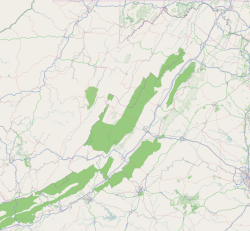Clifton Forge, Virginia | |
|---|---|
 Downtown Clifton Forge | |
| Coordinates: 37°49′11″N79°49′25″W / 37.81972°N 79.82361°W | |
| Country | United States |
| State | Virginia |
| County | Alleghany |
| Settlement | 1700s |
| Williamson's Station | February 13, 1861 |
| Incorporated (town) | October 19, 1884 |
| Incorporated (independent city) | March 31, 1906 |
| Incorporated (town) | January 21, 2001 |
| Named after | The Clifton estate in Lexington |
| Government | |
| • Mayor | Jeff Irvine |
| Area | |
• Total | 3.08 sq mi (7.98 km2) |
| • Land | 3.02 sq mi (7.82 km2) |
| • Water | 0.058 sq mi (0.15 km2) |
| Elevation | 1,080 ft (330 m) |
| Population (2020) | |
• Total | 3,555 |
| • Density | 1,180/sq mi (455/km2) |
| ZIP Code | 24422 |
| Area codes | 540 and 826 |
| FIPS code | 51-17440 [2] |
| GNIS feature ID | 1492780 [3] |
| Website | Official website |

Clifton Forge is a town in Alleghany County, Virginia, United States which is part of the greater Roanoke Region. [4] The population was 3,555 at the 2020 census. The Jackson River flows through the town, which as a result was once known as Jackson's River Station.
Contents
- History
- Geography
- Climate
- Demographics
- 2020 census
- 2010 census
- Government
- Education
- Infrastructure
- Public safety
- Transportation
- Air
- Roads
- Rail
- In popular culture
- Notable people
- Natives
- Politics
- See also
- References
- Further reading
- External links
Clifton Forge was an independent city during the 2000 census. However, in 2001, Clifton Forge gave up its city status and reverted to a town. In previous decades, the railroad was a major employer. Clifton Forge is known for its mountain views and clear streams.





